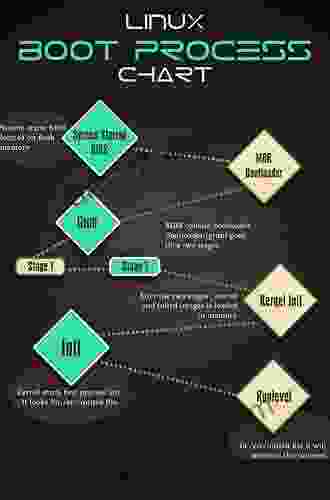Mastering the Boot Process: Unveiling the Secrets of Linux, Windows, and Unix

The boot process is the critical sequence of events that unfolds when a computer is powered on or restarted. It involves a carefully orchestrated series of steps that prepare the hardware, load the operating system (OS) into memory, and ultimately launch the user interface. Understanding the boot process is essential for both system administrators and users alike, as it provides insights into how their computers function and enables them to troubleshoot boot-related issues.
4.4 out of 5
| Language | : | English |
| File size | : | 41875 KB |
| Text-to-Speech | : | Enabled |
| Screen Reader | : | Supported |
| Enhanced typesetting | : | Enabled |
| Print length | : | 490 pages |
This comprehensive guide will take you on a detailed exploration of the boot process in three prominent operating systems: Linux, Windows, and Unix. We'll uncover the intricacies of each system's boot sequence, examining the key components and technologies involved. Whether you're a seasoned IT professional or a curious enthusiast, this article aims to empower you with a profound understanding of this fundamental aspect of computing.
The BIOS and UEFI: Setting the Stage
Before delving into the operating system-specific boot processes, it's crucial to shed light on two foundational components: the BIOS (Basic Input/Output System) and UEFI (Unified Extensible Firmware Interface). These firmware programs reside on the motherboard of a computer and serve as the initial point of contact when the system is powered on.
BIOS: The Legacy Approach
The BIOS has been the traditional method of initializing hardware and booting computers for decades. It's a low-level program that primarily manages hardware initialization, including the POST (Power-On Self-Test) and the identification of connected peripherals. Once the hardware is deemed functional, the BIOS loads a small program called the boot loader into memory and transfers execution control to it.
UEFI: The Modern Successor
UEFI is a more modern and advanced firmware interface that has gradually replaced BIOS in recent years. It boasts a graphical user interface (GUI),support for larger storage devices, and advanced security features. UEFI also provides a more flexible and extensible platform for boot loader management, allowing for the seamless integration of multiple operating systems.
The Linux Boot Process: A Linux Odyssey
Linux distributions employ a highly modular and customizable boot process. It typically involves the following stages:
1. BIOS/UEFI Initialization
As with other operating systems, the Linux boot process begins with the BIOS or UEFI initializing the hardware components. This includes detecting and configuring peripherals such as the hard disk, memory, and graphics card.
2. Boot Loader Invocation
Once hardware initialization is complete, the BIOS/UEFI loads the boot loader into memory. The boot loader's primary responsibility is to locate and load the Linux kernel, the core of the operating system.
3. Linux Kernel Loading
The boot loader reads the Linux kernel from the hard disk and loads it into memory. The kernel is responsible for managing hardware resources, memory allocation, and process scheduling.
4. Initial RAM Disk (initrd)
Some Linux distributions utilize an initrd, a temporary RAM-based file system that contains essential drivers and modules required for the early boot process. The initrd is loaded into memory along with the kernel and provides a minimal environment for loading the rest of the operating system.
5. System Initialization
After the kernel is loaded, it initializes critical system components, such as the file system, device drivers, and networking. This stage also involves mounting the root file system, making it accessible to the rest of the system.
6. Init Process and Runlevels
The init process is the first user-space process launched by the kernel. It reads the system's configuration files and starts additional services and daemons based on the defined runlevels. Runlevels are predefined system states that determine which services and applications are active.
7. Graphical User Interface (GUI) Startup
Finally, the graphical user interface (GUI) is launched, providing the user with an interactive environment to interact with the system. The specific GUI environment used may vary depending on the Linux distribution, such as GNOME, KDE Plasma, or Xfce.
The Windows Boot Process: A Microsoft Masterpiece
The Windows boot process is a well-orchestrated sequence that has evolved significantly over the years. Here's a breakdown of the key steps:
1. BIOS/UEFI Initialization
Similar to Linux, the Windows boot process begins with the BIOS or UEFI initializing and configuring the hardware components.
2. Boot Configuration Data (BCD) Loading
The BIOS/UEFI then loads the Boot Configuration Data (BCD),a database that contains information about the installed operating systems and boot loader settings.
3. Boot Manager Invocation
The Boot Manager, a component of the Windows Boot Loader, is responsible for displaying a list of available operating systems and allowing the user to select the desired one.
4. Windows Boot Manager (Winload.exe)
Once an operating system is selected, the Windows Boot Manager (Winload.exe) is loaded into memory. It's responsible for loading the Windows kernel and other essential components.
5. Kernel Loading
The Windows kernel, known as ntoskrnl.exe, is loaded into memory and begins the process of initializing hardware and system resources.
6. Device Driver Loading
Device drivers for various hardware components are loaded, enabling the kernel to communicate with and control the devices.
7. User Mode Initialization
After the kernel is fully initialized, the user mode portion of the boot process begins. This involves loading the Windows graphical user interface (GUI) and launching the user session.
The Unix Boot Process: A Heritage of Innovation
Unix systems, including macOS, Solaris, and FreeBSD, share a common ancestry and employ a similar boot process. Here's an overview of the typical sequence:
1. BIOS/UEFI Initialization
As with Linux and Windows, the Unix boot process commences with the BIOS or UEFI initializing the hardware components.
2. Boot Block Execution
The BIOS/UEFI loads the boot block, a small program stored in the first sector of the boot device, into memory. The boot block then loads the operating system kernel into memory.
3. Kernel Loading and Initialization
The Unix kernel is loaded into memory and begins initializing system resources, including managing memory, scheduling processes, and setting up the file system.
4. Init Process Startup
The init process, the parent of all user processes, is launched by the kernel. It reads the system configuration files and starts additional services and daemons based on the defined runlevels.
5. Shell Invocation
Once the essential system services are up and running, the init process launches a command shell, typically the Bourne shell (/bin/sh),providing the user with an interactive interface.
Troubleshooting Boot Issues: A Guide to Recovery
Understanding the boot process can greatly assist in troubleshooting boot-related issues. Here are some common problems and potential solutions:
1. No Boot Device Found:
This error indicates that the BIOS/UEFI is unable to detect a bootable device. Ensure that a bootable device, such as a hard disk or USB drive, is properly connected and set as the primary boot device in the BIOS/UEFI settings.
2. Operating System Not Found:
This error suggests that the boot loader is unable to locate the operating system files. Verify that the boot loader configuration is correct and that the operating system files are present on the boot device.
3. Kernel Panic:
A kernel panic occurs when the kernel encounters a critical error and is unable to continue operating. Examine the system logs to identify the root cause and attempt to resolve the underlying issue.
: Empowering You with Boot Process Mastery
Understanding the boot process is not only a technical endeavor but also a gateway to gaining a deeper understanding of how operating systems function. Whether you're a seasoned IT professional or a curious enthusiast, this guide has armed you with the knowledge and insights to navigate the complexities of the boot sequence in Linux, Windows, and Unix systems.
By mastering the boot process, you'll be better equipped to troubleshoot boot-related issues, customize boot configurations, and optimize system performance. Embrace this newfound knowledge and continue your exploration into the fascinating world of computing.
4.4 out of 5
| Language | : | English |
| File size | : | 41875 KB |
| Text-to-Speech | : | Enabled |
| Screen Reader | : | Supported |
| Enhanced typesetting | : | Enabled |
| Print length | : | 490 pages |
Do you want to contribute by writing guest posts on this blog?
Please contact us and send us a resume of previous articles that you have written.
 Book
Book Novel
Novel Page
Page Chapter
Chapter Text
Text Story
Story Genre
Genre Reader
Reader Library
Library Paperback
Paperback E-book
E-book Magazine
Magazine Newspaper
Newspaper Paragraph
Paragraph Sentence
Sentence Bookmark
Bookmark Shelf
Shelf Glossary
Glossary Bibliography
Bibliography Foreword
Foreword Preface
Preface Synopsis
Synopsis Annotation
Annotation Footnote
Footnote Manuscript
Manuscript Scroll
Scroll Codex
Codex Tome
Tome Bestseller
Bestseller Classics
Classics Library card
Library card Narrative
Narrative Biography
Biography Autobiography
Autobiography Memoir
Memoir Reference
Reference Encyclopedia
Encyclopedia Larry Ullman
Larry Ullman David Powers
David Powers Stephen Tvedten
Stephen Tvedten Sri Vishwanath
Sri Vishwanath Weidong Wu
Weidong Wu Wucius Wong
Wucius Wong Bauke Kamstra
Bauke Kamstra Theodore Millon
Theodore Millon Veronica Sarmiento
Veronica Sarmiento Peter Abelard
Peter Abelard Swathi
Swathi Alex Mills
Alex Mills Wendy Northcutt
Wendy Northcutt J M Berger
J M Berger Rokelle Lerner
Rokelle Lerner Tamara Saviano
Tamara Saviano Dr Theresa J Covert
Dr Theresa J Covert Susan Moon
Susan Moon Simon Donovan
Simon Donovan Shae Bynes
Shae Bynes
Light bulbAdvertise smarter! Our strategic ad space ensures maximum exposure. Reserve your spot today!
 Keith CoxFollow ·10.8k
Keith CoxFollow ·10.8k Martin CoxFollow ·11.9k
Martin CoxFollow ·11.9k Ronald SimmonsFollow ·13.6k
Ronald SimmonsFollow ·13.6k Reginald CoxFollow ·5.5k
Reginald CoxFollow ·5.5k Houston PowellFollow ·10.2k
Houston PowellFollow ·10.2k Bruce SnyderFollow ·4.8k
Bruce SnyderFollow ·4.8k Max TurnerFollow ·16.7k
Max TurnerFollow ·16.7k Alex FosterFollow ·6.5k
Alex FosterFollow ·6.5k

 Timothy Ward
Timothy WardSteamy Reverse Harem with MFM Threesome: Our Fae Queen
By [Author...

 Cody Blair
Cody BlairThe Ultimate Guide to Energetic Materials: Detonation and...
Energetic materials are a fascinating and...

 Kenzaburō Ōe
Kenzaburō ŌeProstitution, Modernity, and the Making of the Cuban...
By Emily A....

 Kirk Hayes
Kirk HayesUnveil the Enchanting World of The Rape of the Lock by...
Alexander Pope's epic...

 Ivan Turgenev
Ivan TurgenevTantric Quest: An Encounter With Absolute Love
Embark on a Tantric Quest to...

 Gary Reed
Gary ReedThe Darwin Awards: Evolution in Action
The Darwin Awards are a...
4.4 out of 5
| Language | : | English |
| File size | : | 41875 KB |
| Text-to-Speech | : | Enabled |
| Screen Reader | : | Supported |
| Enhanced typesetting | : | Enabled |
| Print length | : | 490 pages |












